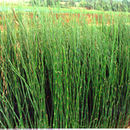Brief Summary
provided by IABIN
Diagnosis Species characterized by the following combination of traits: (1) small size (17.6-20.9mm snout-vent length in males; 20.6-22.3mm in females); (2) in life, dorsum consistently green; (3) in preservative, dorsal surfaces pink; (4) dorsal pattern characterized by two parallel and irregular brown stripes, from posterior corner of orbits to middle of body, followed by a single sacral stripe; (5) absence of a narrow mid dorsal stripe; (6) snout broad, mucronate to slightly truncate in dorsal outline (Figs.1 and 2); (7) eyes not prominent
- author
- Esteban O. Lavilla
- editor
- Diego Arrieta
Distribution
provided by IABIN
Occurs in "cerrado" formations in the states of São Paulo, Minas Gerais, and Mato Grosso do Sul, Brazil and department of Amambay and Canindeyú in Paraguay.
- author
- Esteban O. Lavilla
- editor
- Diego Arrieta
Molecular Biology
provided by IABIN
Flavonas saponinas, equisetonina (9)
Diagnostic Description
provided by IABIN
Adult morphology Head longer than wide, its width contained 3.3 times in snout-vent length; internarial distance greater than eye-nostril distance, and smaller than eye diameter; eye diameter greater than eye to nostril distance; snout mucronate, truncate, or rounded in dorsal outline, and protruding, rounded, or truncate in lateral outline; nostrils not protuberant, directed laterally; canthus rostralis straight or slightly rounded; loreal region oblique; eyes not prominent; tympanum distinct, nearly circular; a supratympanic fold, not well marked, sometimes covering partially the tympanum; vocal sac single and subgular; tongue cordiform, ovoid, or rounded; vomerine teeth, when present, in two small patches between choanae. Forearm more robust than upper arm, and shorter; hand with a distinct palmar tubercle; prepollex distinct; subarticular tubercles rounded; distal tubercle of third and fourth fingers sometimes bifid; supernumerary tubercles present; diameter of the third finger disk larger than of the fourth toe disk; fingers webbed. Legs slender; thigh and shank approximately with the same stoutness and length; sum of thigh and shank lengths shorter than snout.vent length; toes with subarticular tubercles, always rounded; supernumerary tubercles not distinct; prehallux present; toes webbed. Color in preservative:Dorsum pink, with two brown parallel and irregular stripes, from posterior corner of orbits to half of body, followed by a single sacral brown stripe; absence of a narrow mid dorsal stripe; canthus rostralis delimited above by a white stripe and below by a brown stripe; lorus with a variable degree of melanization; flanks with a dorsolateral brown stripe, from the posterior corner of orbits to near the groin, bordered by a white pinkish stripe; thigh light brown and immaculate; a brown stripe on the anterior and posterior edges of the upper surface of tibia, bordered above by a white pinkish stripe, besides random dots over it. Ventral surface immaculate buff. Measurements of holotype: snout-vent length 18.7; head width 5.5; head length 5.7; eye diameter 2.0; upper eyelid width 1.3; interorbital distance 2.1; eye to nostril distance 1.3; internarial distance 1.6; nostril to tip of snout distance 1.0; tympanum diameter 0.9; upper arm length 5.8; forearm length 3.6; hand length 5.4; third finger disk diameter 0.6; thigh length 8.8; tibia length 9.0; foot length 12.7; fourth toe disk diameter 0.5. Variation: The specimens from Brotas (São Paulo) and São Roque de Minas (Serra da Canastra, Minas Gerais), northern distribution, have shorter, broader, and more truncate snouts. Moreover, throughout the "cerrado" corridor that links São Paulo to Minas Gerais, the specimens examined show an increment of incomplete, vestigial, and immaculate dorsum patterns from south to north, suggesting a directional cline, though without statistical inference.
- author
- Esteban O. Lavilla
- editor
- Diego Arrieta
Dendropsophus jimi: Brief Summary
provided by wikipedia EN
Dendropsophus jimi is a species of frog in the family Hylidae. It is endemic to Brazil. Its natural habitats are moist savanna, subtropical or tropical moist shrubland, subtropical or tropical high-altitude shrubland, rivers, swamps, freshwater springs, pastureland, rural gardens, ponds, and canals and ditches. It is threatened by habitat loss.
- license
- cc-by-sa-3.0
- copyright
- Wikipedia authors and editors

